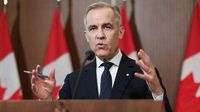In a highly anticipated meeting at the White House on Tuesday, May 6, 2025, U.S. President Donald Trump and Canadian Prime Minister Mark Carney are set to address escalating trade tensions that have strained relations between the two neighboring countries. This meeting marks the first in-person encounter between the leaders since Carney's Liberal Party won Canada’s federal elections last week, a victory many attribute to rising Canadian discontent with Trump’s aggressive trade policies.
Canada is America’s second-largest trading partner, with trade figures from 2024 showing the U.S. exported approximately $349.4 billion worth of goods to Canada, including energy and automobiles. However, the relationship has soured following Trump’s implementation of sweeping tariffs on Canadian imports, which were initially introduced in March 2025 but briefly suspended after Canada and Mexico pledged to address issues related to fentanyl trafficking and illegal immigration.
Despite the suspension, a 25% tariff remains on imports deemed non-compliant with the United States-Mexico-Canada Agreement (USMCA), a trade deal Trump brokered to replace the older North American Free Trade Agreement (NAFTA). Furthermore, Trump has announced additional tariffs on cars, auto parts, steel, and aluminum, significantly affecting Canadian exports.
In retaliation, Prime Minister Carney's government has imposed its own 25% tariffs on approximately C$60 billion (about $44 billion) worth of American goods, including cars and metals. In a defiant post-election speech, Carney stated, “We are over the shock of the American betrayal, but we should never forget the lessons.” This sentiment reflects the growing frustration in Canada regarding Trump’s trade tactics.
Trump’s tariffs have had a noticeable impact on both economies. General Motors CEO Mary Barra recently indicated that these tariffs might cost her company between $4 billion and $5 billion this year. Additionally, small businesses are feeling the pinch; for instance, Busy Baby, a baby products company, reported that shipping costs for a container of goods have surged to nearly $230,000.
Moreover, the Federal Reserve’s latest Beige Book highlighted a decline in cross-border tourism from Canada, which has traditionally supported businesses in areas like Northern Washington and Southern California. Reports indicate that Canadians are opting for domestic products over American ones, with some choosing to buy Ontario meats instead of U.S. pepperoni and sparkling water sweetened with Canadian maple syrup over Coca-Cola.
As the meeting approaches, the stakes are high. Commerce Secretary Howard Lutnick noted that while a deal with Canada is possible, it would be “very complex.” The meeting comes at a time when Trump has been criticized not only for his tariffs but also for making unfounded claims about Canada’s military spending and trade deficit. CNN fact-checker Daniel Dale recently debunked Trump’s assertion that Canada has a massive trade deficit with the U.S., clarifying that the actual goods and services trade deficit was about $36 billion in 2024, significantly lower than Trump’s claims of $200 billion.
During the Oval Office meeting, Trump praised Canada, stating, “Regardless of anything, we’re going to be friends with Canada.” However, he has previously mused about making Canada the “51st state,” a notion that Carney firmly rebuffed, emphasizing that Canadian sentiments on this issue are unlikely to change. Carney expressed gratitude for Trump’s hospitality but made it clear that the tariffs imposed by the U.S. were not sustainable for either country.
In the wake of these trade tensions, the political landscape in Canada has shifted. Carney’s election victory was seen as a direct response to Trump’s policies, with many Canadians rallying behind the Liberal Party’s stance against the U.S. leader’s aggressive tactics. The election results underscore a growing sentiment within Canada that is increasingly wary of American influence.
As the meeting unfolds, all eyes will be on the two leaders to see if they can find common ground amidst their differences. The outcome could have significant implications for the future of trade relations between the two countries, which have historically been strong but are currently under strain.
Trump has previously indicated that he believes the U.S. maintains a trade advantage over Canada and other nations affected by his tariffs, stating, “We don’t have to sign deals because the United States has the more desirable market.” This perspective may complicate negotiations as both leaders seek to navigate the complex landscape of international trade.
While the meeting is expected to touch on various issues, including trade, military spending, and regional security, the focus will likely remain on how both leaders plan to address the tariffs that have created a rift in their long-standing partnership. With Carney’s recent election victory and a strong mandate to resist Trump’s policies, the Canadian Prime Minister is poised to advocate for a more equitable trade relationship.
As the world watches, the meeting between Trump and Carney could either pave the way for renewed cooperation or deepen the divide between the two nations. The outcome will undoubtedly have lasting effects on the economic and political landscape of North America, making this a critical moment in U.S.-Canada relations.





